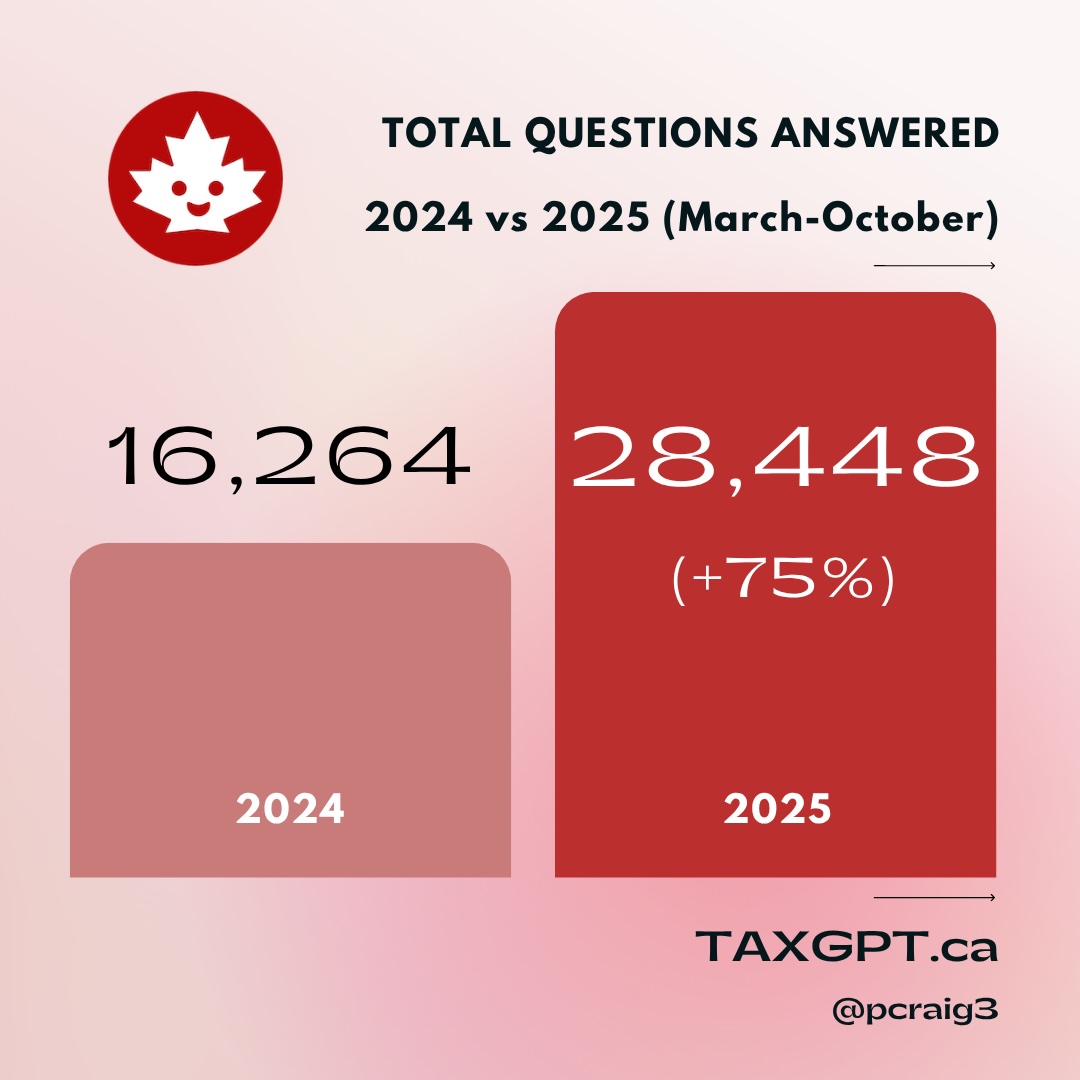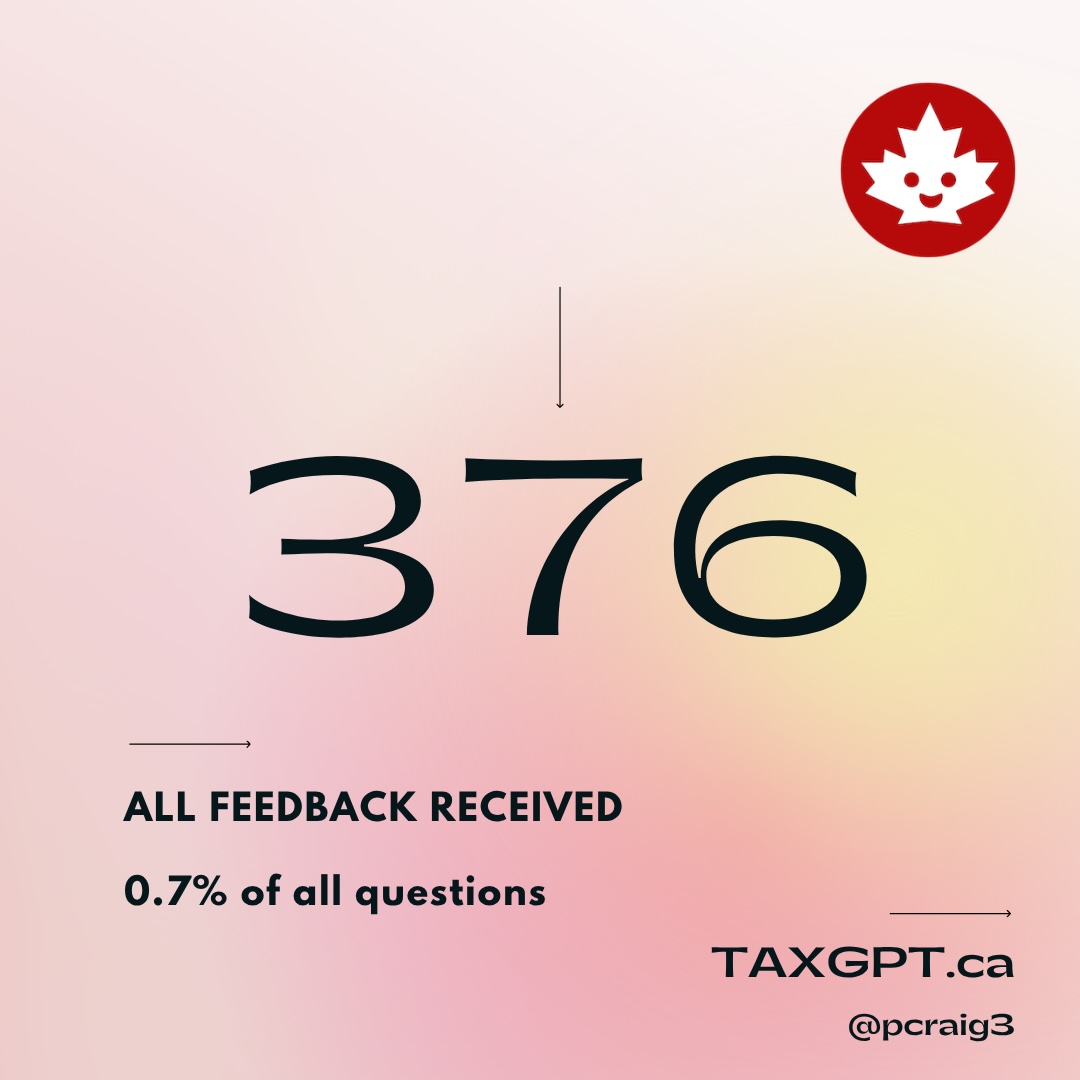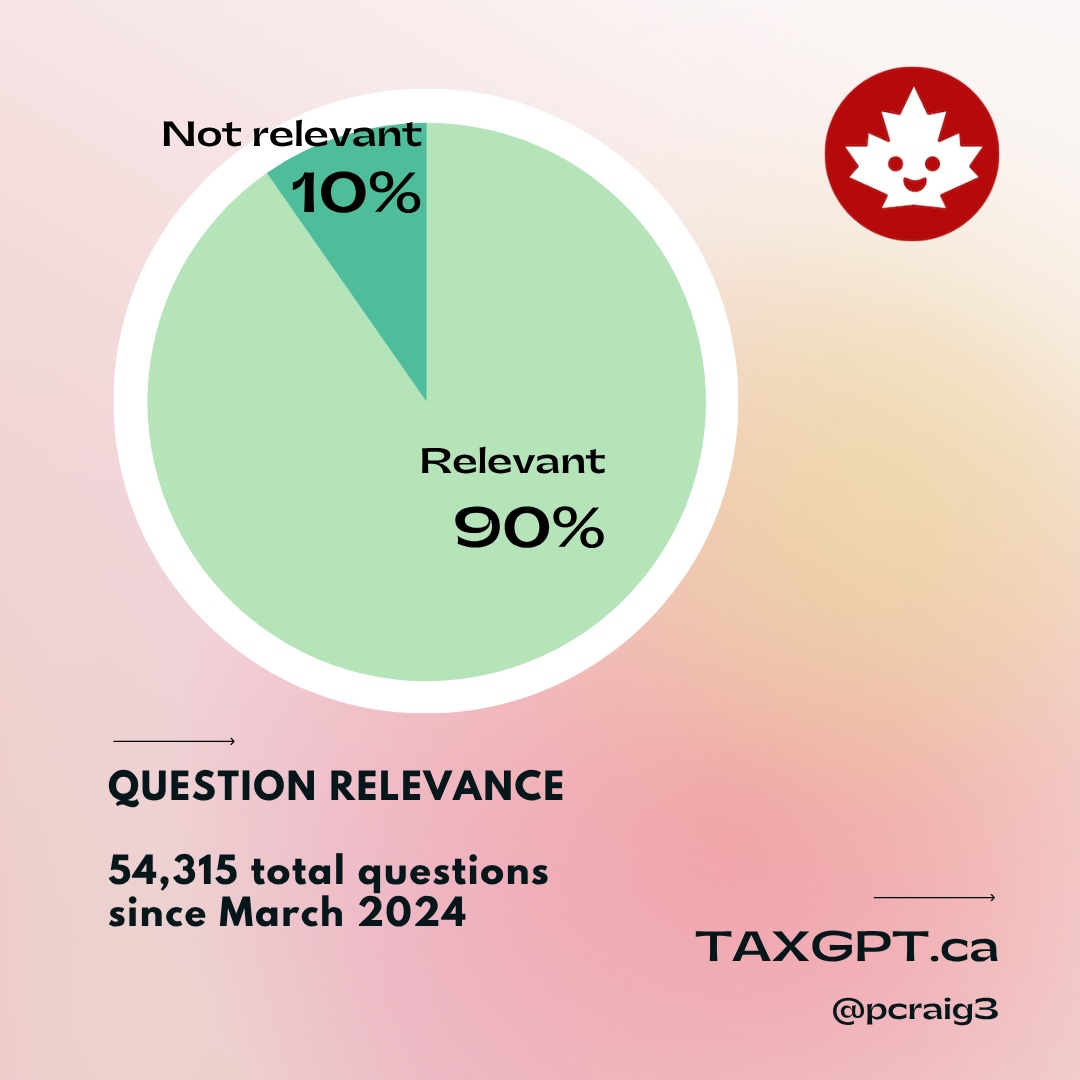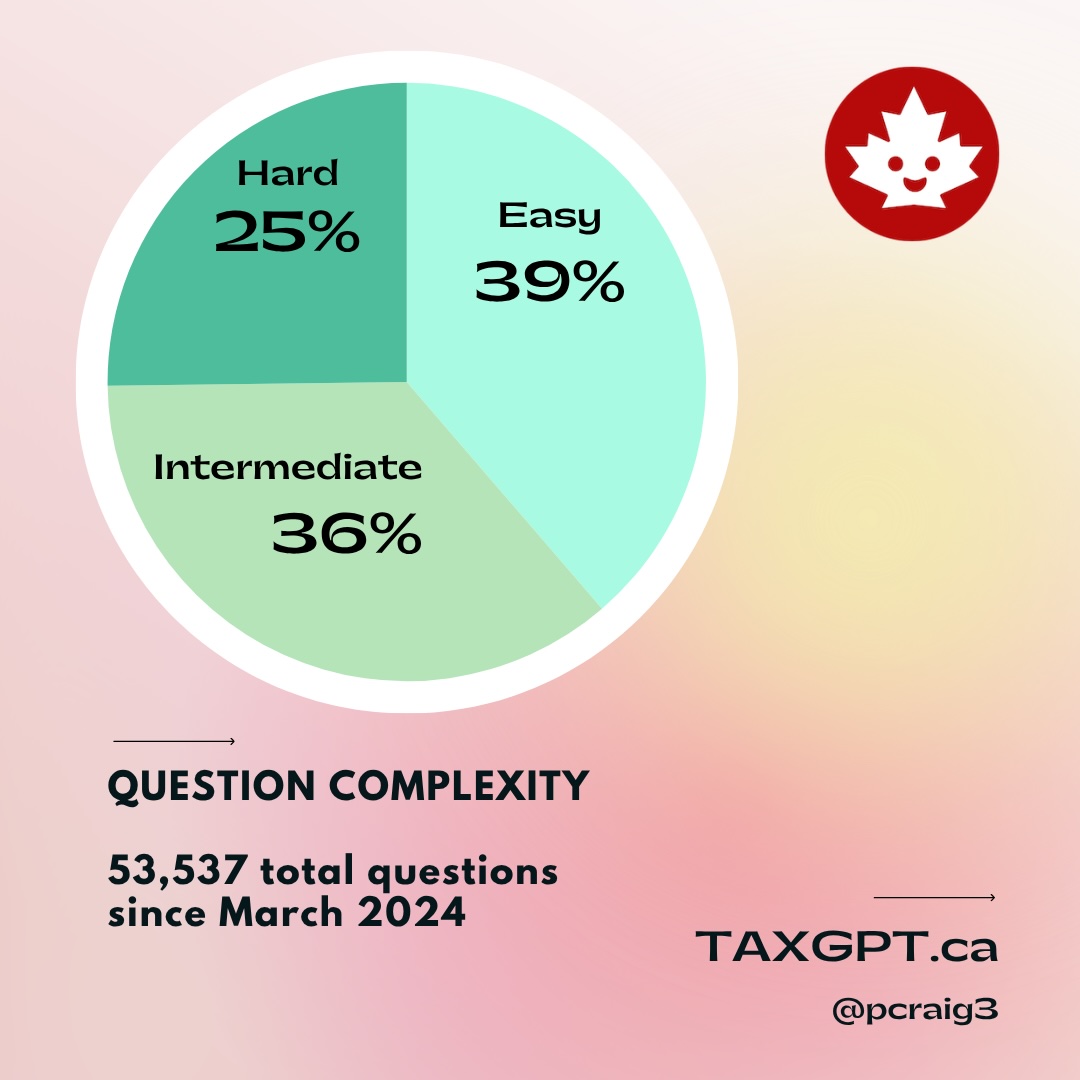TaxGPT usage and data analysis (2025)
On this page
Overview
TaxGPT was an early entrant to the buzzy “AI-app” category, courageously trailblazing a path now followed by a stampede of companies trying to lay off customer support staff. For that, I apologize.
However, I am very much not a company trying to offload support. I’m just a guy who thinks that AI is cool and taxes are harder than they need to be. (Not for long, hopefully!) I’m also not really trying to make money with TaxGPT — which is convenient because I am clearly very bad at it.
I come from a public service background where I was responsible for building digital services to help citizens. TaxGPT is exactly like that, except instead of being taxpayer-funded, I am funding tax-paying.
A little over a year ago, I shared TaxGPT’s usage data during March and April, which is ‘tax filing season’ here in Canada. Today, I am following up with even more data, because it’s been long enough that I can make useful year-over-year comparisons.
The major takeaway is that TaxGPT is trending up. Even as others have entered the fray (CRA has their GenAI bot now, Google has AI Search), TaxGPT’s usage numbers are growing. Coming from nowhere and capturing a steadily growing audience share, TaxGPT is an inspirational rags-to-rags story of a plucky app that just keeps helping people out — long may it continue!
Usage numbers
I don’t use paid advertising for TaxGPT because I don’t make money off usage or traffic — it’s actually the opposite. This means that anyone who ends up on taxgpt.ca wants to be here.
I offer TaxGPT for free and I plan to keep it that way as long as there is interest. But gauging interest over time is a bit tricky. Comparing usage numbers month-to-month doesn’t make a lot of sense: way more people are looking for tax information the day before the tax filing deadline (April 30) than the day after. For a fair comparison, we need to look year-over-year.
Data
| Month* | 2024 | 2025 | Growth % |
|---|---|---|---|
| March | 2521 |
6387 |
153% |
| April | 5988 |
8461 |
41% |
| May | 1480 |
2842 |
92% |
| June | 1040 |
2190 |
111% |
| July | 1070 |
2037 |
90% |
| August | 1288 |
1632 |
27% |
| September | 981 |
1841 |
88% |
| October | 1896 |
3091 |
63% |
| Total | 16264 |
28481 |
75% |
* Note that I don’t have data for Jan-Feb 2024 or Nov-Dec 2025 (yet), so I only compare months where I have data for both years.

Analysis
Overall, excellent news. In 2025, I am seeing roughly the same pattern as 2024 — lots of interest in March and April, and a big dip in the summer — but every single month has seen significantly more questions come through than in the previous year.
Extrapolating a 75% annual growth rate going forward, I am looking at 18 billion questions in 2051, at which point I really will have to think about introducing a freemium model.
Trending topics
In 2024, the top sources referenced by TaxGPT could be sorted into 2 general topics:
- basic information about tax filing
- specialized information about business expenses
In 2025, this is changed:
- Self-employed Business Expenses
- Sole Proprietor: Business expenses
- Capital Gains – 2024
- Employment Expenses 2024
- Federal tax and benefit information for 2024
Analysis
To clarify: when you file your taxes in April 2025, you are actually filing your 2024 tax return because you are reporting your income for the 2024 calendar year.
So the prevalence of “2024”-titled pages refers to new information indexed by TaxGPT. This is good! One of the major downsides of ChatGPT is that it can be months (or even years!) out of date. This is fine if you are learning about the rules of Groundhog Day, but if you need up-to-date tax information, you don’t want to be referencing what CRA’s website said 2 years ago. I update TaxGPT on a weekly basis, so it always serves fresh, reliable tax info.
The other notable difference is that ‘basic tax information’ is no longer represented. Instead, more submitted questions touch on ‘higher-complexity’ subjects like business expenses, capital gains, and employment expenses. This makes sense to me: the kind of person who seeks out TaxGPT likely has a question that is not clearly answered by the new Google AI Search.
Feedback
TaxGPT uses thumbs-up/down icons to collect explicit feedback from users on what they think of the answers that come back. Let’s look at how many people actually use them and what they are feeding back.
Data
| Feedback type | Mar 2024 - Apr 2024 | Mar 2024 - Oct 2025 |
|---|---|---|
| Positive | 43 (56%) |
202 (54%) |
| Negative | 34 (44%) |
174 (46%) |
| Total | 77 |
376 |
| Total as a percentage of all questions | 0.9% |
0.7% |

Analysis
It is interesting that the ratios are so similar 1 year later. As before, about 55% of feedback is positive, and fewer than 1% of questions come with explicit feedback.
I look at all submitted feedback and I improve what I can, but I don’t have to agree with everything. For example, several negative feedback messages have been about TaxGPT’s question length limit of 2000 characters. I can live with that. I don’t think anyone should ask questions that are that long, as it reduces the chances of getting a clear, focused answer.
People also email me about TaxGPT, sometimes detailing problems or inaccuracies they have noticed. These messages are extremely valuable to me, and I act on them quickly.
The lesson here? Few people leave feedback, but those who take the time to respond are worth paying attention to (unless they are complaining about the character limit).
Relevance
TaxGPT tags incoming questions as ‘relevant’ or ‘not relevant’ to tax filing, which helps it decide how to answer them. The proportion of relevant questions is an important metric, as I don’t want people spamming me with garbage or trying to ‘prompt inject’ me.
Data
| Description | Mar 2024 - Apr 2024 | Mar 2024 - Oct 2025 |
|---|---|---|
| Relevant questions | 6927 (85%) |
49084 (90%) |
| Not relevant | 1224 (15%) |
5264 (10%) |

Analysis
This is terrific! TaxGPT is free to use, but that means I am risking abuse, because it is free to spam me. However, looking at this data, we can see that TaxGPT is overwhelmingly being used as intended. It’s also improved proportionally since 2024, which is a trend that I would like to see continue. So, if you are asking TaxGPT about Groundhog Day, please stop. There is a whole other website for that.
Complexity
In addition to tagging questions for relevance, every question submitted to TaxGPT is estimated to be either “easy”, “intermediate” or “hard” to answer. TaxGPT is great at ‘easy’ questions, pretty good at ‘intermediate’ ones, and can be hit-or-miss with complex, ’expert-level’ questions.
The complexity metric was developed in collaboration with Mehdi Mammadov, a data scientist with Antennai LLC.
Data
| Description | Mar 2024 - Apr 2024 | Mar 2024 - Oct 2025 |
|---|---|---|
| Easy | 2088 (28%) |
20725 (39%) |
| Intermediate | 4213 (56%) |
19320 (36%) |
| Hard | 1234 (16%) |
13525 (25%) |

Analysis
Most people ask ‘easy’/‘intermediate’ questions, which is good news. TaxGPT is proficient with these kinds of questions, so it is reassuring to see that the lion’s share fall within this range.
However, the proportion of ‘hard’ questions has gone up (by nearly 10%!), which is a likely result of a more sophisticated audience — I would guess that many of these are ‘expenses/capital gains-related’ questions that we see represented in the trending topics above ☝️.
Whatever the case, the majority of questions coming in are absolutely the kinds of questions I built TaxGPT to provide answers to.
Conclusion
TaxGPT began as an experiment that I built in the public lobby of the National Arts Center in Ottawa. The earliest iteration of it “took about 40 to 50 hours to develop TaxGPT and [...] cost about $60”, as I told the National Post. I’ve since spent many more hours and dollars improving TaxGPT, and it is gratifying to watch as it continues to help more and more people every day.
TaxGPT relies entirely on organic search and word-of-mouth, but this means that it has to work — otherwise, people won’t search for TaxGPT or tell their friends about it. The good news is that it is working. Usage numbers are way up, most questions are relevant, and generally the feedback I get is positive. Coming from my background in public service, this is exactly what you want to see.
Since 2023, I’ve been inundated with AI widgets appearing in almost every app I rely on. The majority of these new AI tools are things that I didn’t ask for, don’t care about, and never use — and I don’t think I am alone here.
TaxGPT is a rare example of an app that people actually look for, and increasingly so. The key to its success? Start with user needs, ship quickly, act on feedback, and keep an eye on how things are going day-to-day.
That's it, thanks for reading and I hope you enjoyed these insights! I’m also available for a chat at “paul [a] pcraig [dot] ca” if you want to bump my “positive feedback” metric or chat AI in general! The best way to learn is by doing, the second best way is to learn from somebody that has done it already.
